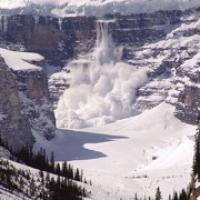Moving stones are a natural phenomenon. Moving stones of the valley of death Mysterious moving stones
Moving stones are one of the biggest mysteries of science. They are located in Death Valley, a US National Park with an area of about 13,800 km². Scattered over a vast area, boulders of different sizes tend to move, leaving grooves in the sand - traces of their movement.
Moving stones are one of the biggest mysteries of science
In the late 40s, geologists Jim McAllister and Allen Agnew made the first map of the location of boulders and their traces. Later, employees of the US National Park Service joined the process. After this, the information became available to readers of Life magazine, on the pages of which they published photographs of the boulders along with facts about them known at that time.
For a long time, the study of the moving stones of Death Valley was the subject of pseudo-scientific speculation. Most hypotheses explained what was happening by the unusual behavior of the wind at the bottom of the dry lake Racetrack Playa.
In the mid-50s, geologist George Stanley, studying the phenomenon, came to the conclusion that the stones were too heavy to move with gusts of wind. The scientist suggested that during seasonal flooding of the lake, a layer of ice forms on its surface, facilitating the movement of stones.
If we do not take into account theories about the influence of supernatural forces and electromagnetism on boulders, then all concepts about crawling stones boiled down to the following 2 factors:
- Slippery surface under a stone(dirt or ice). This is confirmed by the shape of the footprint. Crawling blocks leave behind grooves with clear edges, which means that the soil was initially soft and did not prevent sliding.
- Wind pushing boulders.
At that time, there was a theory that stated that air masses did not act on the blocks themselves, but on the pieces of ice that had grown on them. In this way, the stones formed peculiar sails, and due to the increased area of contact with the atmosphere, the boulders could move faster.
In addition, some scientists suggested that the cause of the phenomenon was an earthquake. But Death Valley is a quiet place in terms of seismic activity, which is why this idea was quickly rejected.

Research by Californian scientists
In the spring of 1972, Robert Sharp and Dwight Carey began a program to monitor boulder movements. For this purpose, 30 blocks with fresh traces were selected, each of which was given a name. The researchers used stakes to indicate their initial position. It took scientists about 7 years to formulate their theory. It was as follows:
- During the rainy season, water accumulates in the southern part of Racetrack Playa.
- The wind carries moisture along the bottom of a dry lake.
- Clay soil gets very wet.
- Since the friction force has decreased significantly, the wind blows away even the largest blocks weighing more than 300 kg.
This study also tested the idea that ice moves rocks. On winter nights, the temperature in the valley can sometimes be below zero. Then the water, driven by air masses, becomes covered with a layer of ice, into which the boulders freeze.
The Mystery of the Crawling Stones (video)
Scientists conducted an experiment: among the moving stones, one small one (about 0.5 kg) was selected, around which a pen of 1.7 x 1.7 m was built with a support distance of 65-75 cm. It was assumed that when sliding, the ice could catch on the fence, causing why the trajectory of movement will change. In the first winter, the stone moved 8.5 m, past the supports, which refuted the hypothesis. The following year, 2 large boulders were placed in the pen. It took one of them 5 years to move in the same direction as the stone from the first experiment. The second one remained in place.
In the first winter of research, only a third of the stones began to move, with one of the boulders named Mary Ann crawling almost 65 m. In subsequent years, others joined them. In just 7 years, out of 30 boulders, only 2 did not move. The smallest of the stones, Nancy, moved the maximum total distance - 262 m, of which it crawled 201 m in one season.
Gallery: stones of Death Valley (55 photos)

Dissertation by Paula Messina
In the early 90s, Paula Messina from the University of San Jose became interested in Death Valley. The researcher preferred to call the stones dancing. The phenomenon impressed the woman so much that she devoted her dissertation to atmospheric and geological phenomena at the bottom of Racetrack Playa.
In her work, Paula Messina used the capabilities of GPS, so the data she obtained was more accurate than that of previous researchers. Thanks to the tracking system, it was possible to observe the trajectory of movement with an accuracy of 2-5 cm.
It was found that the stones mostly crawled parallel. From this Messina concluded that ice had nothing to do with the process. After studying the trajectory of 162 blocks, the researcher came to the conclusion that neither their size nor shape affects sliding. At the same time, it was discovered that the change in the coordinates of the boulders depends on their original location at the bottom of Racetrack Playa.

Messina suggested that the air masses above the lake behave in a strange way. After the storm, 2 streams are formed, which is explained by the relief features of the mountains surrounding the lake. This leads to the fact that stones located in different areas move in opposite, often perpendicular, directions. In the center of Racetrack Playa, air currents collide and, twisting, form a tornado. Thus, moving from one part of the lake to another, the boulders are exposed to different winds each time. This can explain the fact that stones move along complex trajectories.
In 2014, one of the non-profit scientific publishing projects published a paper, the authors of which described in detail the traces of boulders. The researchers placed several stones weighing from 5 to 15 kg on the bottom of Racetrack Playa, before installing tracking sensors and cameras on them. During the experiment, it was possible to establish that the stones moved due to huge (several tens of meters in diameter) and very thin (up to 1 cm) areas of ice. Carried by the wind, the boulders slid at speeds of up to 5 m per minute.
The most mysterious stones of our planet (video)
Death Valley still attracts scientists. Science still has to answer a number of questions. For example, why do some boulders move great distances every winter while others remain in place for years? Can this be explained by the fact that the bottom of a dry lake is moistened unevenly? Also, recent studies have not yet explained why the valley is covered with stones evenly, whereas due to regular winds, the bulk of them should be concentrated along the perimeter of Racetrack Playa.
It's worth noting that Death Valley is not the only place where moving boulders can be found. A similar geological phenomenon is observed in southern Romania, as well as on the Moon and Mars.
Attention, TODAY only!
At first glance, the deadest thing on earth is a stone. However, according to geological evidence, every stone grows larger in size and changes over millennia, but people with their short lifespan are not destined to see this. However, there are facts when immovable boulders change location, leaving behind visible traces of movement. Such phenomena are called “moving stones”, “wandering stones”, and in the scientific community - “erratic boulders” from the Latin. "erraticus" - "wandering".
Blue stone
The Blue Stone, revered since pagan times, is considered the largest in the world. This mysterious stone is located near the village of Gorodishche near Pereslavl-Zalessky. Its history is quite interesting. According to ancient Russian legends, a spirit that makes dreams come true lived and still lives in this boulder.
That is why at the beginning of the 17th century, when the church entered into a decisive struggle with the remnants of paganism, the deacon of the Pereslavl Semyonovskaya Church Anufriy ordered to dig a large hole, throw the Blue Stone into it and pour a large mound on top. But a few years later, the legendary stone mysteriously peeked out from under the ground. 150 years later, the church authorities of Pereslavl decided to lay a “magic” stone at the foundation of the local bell tower.
The stone was loaded onto a sleigh and transported across the ice of Lake Pleshcheevo. The ice could not stand it, and the Blue Stone sank at a depth of 5 m. Soon, fishermen began to notice that the boulder was slowly moving along the bottom. 50 years later he ended up on the shore at the foot of Yarilina Mountain, where he lies to this day.
Buddha Stone
In Tibet, the monks of the ancient Northern Monastery have been compiling a biography of the so-called Buddha Stone for fifteen hundred years. According to legend, his palms were imprinted on the stone. This boulder weighs 1,100 kg and is famous for the fact that it independently, without anyone’s help, climbs a mountain 2,565 m high, and then descends from it along a spiral trajectory. Each such amazing ascent and descent fits into a period of 16 years.
Moving stones of Death Valley
A well-known area of moving stones is the Death Valley National Nature Reserve, located in the state of California (America). This large, flat, deserted clay plateau, known for its extreme heat, has earned the status of the hottest place on our planet. Thus, in 1917, a record temperature of 48–50 °C remained here for 43 days.
The natural phenomenon of moving stones is constantly recorded in Death Valley, which attracts the attention of researchers. Most often, moving stones (the most ordinary in appearance and chemical composition, ranging in size from small cobblestones to huge boulders weighing half a ton) make their mysterious “walks” along the bottom of the dry salt lake Restrike.
The stones move slowly, sometimes zigzag, covering tens of meters of path, avoiding obstacles and leaving clearly visible traces in the sandy soil. They do not roll, do not rotate, but crawl along the surface, as if someone invisible is pulling them along.
Experts have repeatedly tried to capture moving stones, but so far to no avail: people just can’t capture boulders as they move. But as soon as observers leave, the boulders begin to move - sometimes up to half a meter per hour. The absence of someone else's tracks next to the clearly visible trace of the stones (which has been confirmed more than once even by experienced criminologists) makes it possible to unequivocally state that the stones move without outside help and often against the wind.
Dead stone
Lake Bolon in the Khabarovsk Territory is also a famous point on the world map of “moving stones”. According to one legend, there, at the western end of the lake, there is a famous “tourist” - a one and a half ton boulder, which the local population - the Nanais - nicknamed the Dead Stone. It can lie there for years, then it begins to wander, leaving traces. Local residents believe that the evil spirit Amba lives inside it, and as a rule they avoid it. The outline of the stone resembles a tiger, and its miraculous movements are associated with the actions of great shamans.
When the sorcerer, who performed his rituals at the foot of the Dead Stone, died, the stone block disappeared. But soon she suddenly appeared in another village, with another shaman. The old people say that the boulder moves to its new owner by swimming - first along the river, and then along Bolonya. And from time to time, the stone simply goes into the lake, leaving behind gigantic deep furrows, as if someone’s hellish harrow had really been dragging a heavy inert block behind it for a long time and stubbornly.
Scientists from the Khabarovsk Institute of Water and Environmental Problems believe that the mystery of the Dead Stone lies in the specific behavior of a unique lake, which either increases in size or dries up to the size of a muddy puddle. Perhaps such unusual fluctuations in water level cause the process of movement of stones on the shore.
Valley of Ghosts
There are miracles of this kind in Crimea. As you know, Mount Demerdzhi, or more precisely, its slopes, is a unique pile of rocks, which are commonly called “blocky chaos”. The shape and size of the blocks are so bizarre that strange, sometimes frightening silhouettes are seen in them. Casting long shadows, the stone figures change their outlines, in which it is possible to see more and more new images. This strange place was nicknamed the Valley of Ghosts, and the huge “moving stones” scattered throughout the valley pose a mystery to domestic and world geology.
Mystics believe that otherworldly entities live in “moving stones.” At the beginning of the third millennium, world science was enriched by the extravagant theory of biologists from France Arnold Rechard and Pierre Escolier. They believe that stones are living beings with an ultra-slow life process.
The “breathing” of the stones was recorded by sensitive instruments in the form of a weak but regular pulsation of the samples, and the movement was recorded using special accelerated photography. But all this happens extremely slowly: one breath every two weeks, one millimeter in a few days. In addition, scientists say, stones change structurally, that is, they have age - they can be old and young.
In turn, hardened materialists find more realistic explanations for the mystery of the “moving stones.” One of the simplest and most quickly failed versions is the influence of rain and wind. Initially, it was assumed that the stones move because when it rains, the clay soil becomes slippery, and the smooth boulder begins to slide, driven by gusts of wind.
1978 - a group of Hampshire College employees decided to test the “rain version” in practice. The soil was moistened generously with water, the whole group piled on the stone, but did not move it from its place. Then they calculated that even on wet clay the friction force is such that a stone weighing half a ton can only be “blown away” by a wind rushing at a speed of 400 km/h. And such hurricanes are even theoretically difficult to imagine. In addition, in Death Valley, rain is extremely rare, and many stray stones “crawl” towards the blowing wind.
There are amazing cases where boulders not only move slowly, but actually grow out of the ground. Thus, residents of northern Europe have to uproot strange stones of a smoothed round shape from the soil every year. In some regions (for example, in Finland), stone fences are built from such boulders. There you can also see entire pyramids of “found stones” collected in agricultural lands.
Huge areas in the Baltic countries, Belarus, north-west Russia, and also in North America are also densely “populated” with boulders. According to scientists, the culprits for the appearance of stone placers in fields and arable lands, which are so annoying for farmers, are ancient glaciers. Once upon a time, moving from north to south, huge masses of ice carried along fragments of rocks. Over time, the stones gradually acquired a spherical or oval shape. And now these “guests” from the past appear again and again on the surface of the earth, disabling agricultural machinery.
One of the hypotheses explaining the appearance of moving stones is daily temperature fluctuations. Stones are known to expand when heated, which becomes a common cause of destruction of buildings. Laser measurements show that in the summer months the walls of houses illuminated by the sun become larger and seem to tilt towards the south.
Perhaps, warming up during the day from the sun's rays, the “moving stones” of Death Valley are expanding to the south. With the onset of night coolness, they begin to decrease, and more quickly on the northern side, where they were less warmed up. As a result, lifeless matter moves to the south. And from under the ground, stones “crawl” up towards the sun and warm surface.
One of the latest assumptions belongs to American geologist Jim Reed from the University of Hampshire (Massachusetts), who believes that the stones on the plateau in California are moved by a crust of ice, which, according to him, covers Death Valley in the winter and is sometimes moved by the wind.
Proponents of another theory believe that restless behavior depends on the specific gravity of the stone. In sand or dense clay, “Archimedean forces” can act on a boulder, causing it to float up and move - but all this happens very slowly. But, according to evidence, traveler stones can “shoot” out of the ground like a cannonball.
It has also been suggested that stones can “walk” due to changes in the gravitational field, vibrations and soil subsidence. If the stones were sliding under the influence of banal gravity, then they would all have gathered in the lowlands long ago, but, nevertheless, many of these mysterious travelers move up the slopes.
In this connection, some scientists believe that the phenomenon of self-propelled stones is the result of a distortion of the geomagnetic properties of the planet. After all, boulders “wander” precisely in places of greatest geomagnetic disturbance. But no one can yet explain exactly how the geomagnetic field turns into an anti-gravity field capable of moving huge boulders.
Most likely, most people will agree that in nature it is hardly possible to find an object more lifeless and unshakable than a stone. However, if we take a closer look at the issue of stones, it turns out that they are far from so simple. According to recent research, stones are able to breathe, age, think and move. Let us dwell in more detail on moving stones.
Death Valley attracts the attention of scientists and extreme tourism enthusiasts from around the world for various reasons. But, first of all, every person who comes here wants to personally look at the stones lying at the bottom of the dried prehistoric lake Racetrack Playa. It would seem, what could be interesting in ordinary fragments of dolomite rock from the nearest hill? The point is that they are moving. It is interesting to note that no one has yet recorded how the movement of stones occurs. As a result, this mysterious phenomenon gave rise to a number of theories according to which the following natural phenomena could have caused the movement of stones:
It must be said that to date, none of the theories has completely satisfied the world scientific community. And the phenomenon of moving stones remains a mystery to this day.
Blue-stone, or the heart of a pagan god
Dead stone of Lake Bolon
Another famous erratic stone is located in the vicinity of Lake Bolon (Amur Region). Local residents call this boulder, weighing 1.5 tons, the Dead Stone. According to legend, it contains the spirit of Amba, an evil spirit. Previously, he helped shamans perform witchcraft, but now he simply travels, either going into the lake or returning to the surface.
Ancient Buddha Stone
There is a Northern Monastery in the mountains of Tibet. Its inhabitants have been observing the Buddha stone for 1,500 years, on which, according to legend, the Enlightened One left his palm prints. The age of this boulder weighing 1100 kg is estimated at 50 million years.
This stone rises along a spiral path up a mountain 2.5 km high, and then descends from it in the same way, making an additional circle near the foot. It takes a stone 60 years to go through a full cycle of movement.
King Arthur's Stone - the Wanderer from Wales
Great Britain also has its own legendary stone. We are talking about a huge boulder, weighing 25,000 kg, located in Wales. Without outside help, this stone sometimes unexpectedly ends up on the seashore, and then returns in the opposite direction. The local population believes that the stone sometimes wants to drink salty sea water.
Among this bare space are scattered boulders - seemingly ordinary ones, ranging in size from a soccer ball to half a ton in weight. And these stones tend to change their location, leaving visible traces of their movement. And this is not the only such place on the planet. Covering an area of 3.3 million acres, Death Valley is considered the largest park in the United States and neighboring countries. From the west, Death Valley is supported by Telescope Peak, rising to a height of 11,049 feet. And in the east, the valley abuts the foot of Mount Dante's View, from a height of 5,475 feet which offers stunning views of almost the entire valley.
Death Valley is, first of all, a dramatic desert - the unusual wild, pristine nature and magnificent landscape of which are of geological, historical and artistic interest to researchers and tourists.

The lowest point in the Western Hemisphere, Badwater, is 282 feet below sea level.

Death Valley got its name from settlers who crossed it in 1849, seeking the shortest route to the California gold mines. The guidebook briefly reports that “some stayed there forever.” The survivors withered on the wreckage of dismantled carts the meat of the mules who had lost in the struggle for the meager supply of water and arrived, leaving behind “cheerful” geographical names: Death Valley, Funeral Ridge, Last Chance Ridge...
30 years later, in 1880, deposits of borax (Borax) were found here and a mine was built for its extraction and processing. The only domestic animals that survived were mules, which were used to transport borax from the valley. 20 mules were harnessed to a special 30-ton cart, consisting of two cars with a barrel of water attached to the back. In 1906, the Pacific Coast Borax Company ceased mining borax in the Valley, but The 20 Mule Team and the famous muleteer Borax Bill became one of the most prominent icons in the history of the American Wild West. The road along which the borax was exported still exists today and is called the “20 Mule Team Borax route.” But this is not what makes the Valley so remarkable. Oddly enough, this is one of the most beautiful places in California and, perhaps, in the USA.

In a vast area of the valley, located below the level of the World Ocean, and which was once the bottom of a prehistoric lake, one can observe the amazing behavior of salt deposits. This area is divided into two zones of different textures and shapes of salt crystals. In the first case, salt crystals grow upward, forming bizarre pointed piles and labyrinths 30-70 cm high. They form a foreground that is interesting in its chaos, well emphasized by the rays of the low sun in the morning and evening hours. Sharp as knives, the growing crystals on a hot day emit an ominous, unique crackling sound... This part of the valley is quite difficult to navigate and the presence of good boots is absolutely necessary. This place, apparently due to its ruggedness, was called the Devil’s Golf Course by some joker. The name stuck.

Nearby is the lowest area in the Valley, Badwater, located 86 meters below the level of the World Ocean. Salt behaves differently here. A uniform salt grid 4-6 cm high is formed on an absolutely flat white surface. This grid consists of figures gravitating towards a hexagon in shape, and covers the bottom of the Valley with a huge web, creating an absolutely surreal, unearthly landscape.

Death Valley, a US national wildlife refuge, is located in eastern California, almost at the border with Nevada and is the lowest (86 meters below sea level) place in the Western Hemisphere and the hottest place on Earth. It's about a three-hour drive from Los Angeles. In the southern part of Death Valley is a flat, level clay plain - the bottom of the dry lake Racetrack Playa - called Racetrack Playa. According to the very phenomenon found in this area - “self-propelled” stones.

Something supernatural is happening in Death Valley. Huge boulders crawl along the bottom of a dry lake by themselves. No one touches them, but they crawl and crawl. Nobody saw them move. And yet they stubbornly crawl, as if alive, occasionally turning over from side to side, leaving behind traces stretching for tens of meters. What do these stones need? Where are they crawling? For what?


The Blue Stone is a legendary boulder located near the village of Gorodishche near Pereslavl-Zalessky. According to ancient Russian legends, a certain spirit lives in this stone, fulfilling dreams and desires. At the beginning of the 17th century, the church entered into the fight against pagan religion. Deacon of the Pereslavl Semyonovskaya Church Anufry ordered to dig a large hole and throw the Blue Stone into it. But a few years later, the boulder mysteriously peeked out from under the ground. After 150 years, the church authorities of Pereslavl decided to lay a “magic” stone at the foundation of the local bell tower. The stone was loaded onto a sleigh and transported across the ice of Lake Pleshcheevo. The ice broke, and the Blue Stone sank at a depth of five meters. Soon the fishermen began to notice that the boulder was slowly “stirring” along the bottom. Half a century later, it ended up on the shore at the foot of Yarilinnaya Mountain, where it still lies... This and similar stones gave scientists a riddle that they have been struggling with in vain for decades. What assumptions are made about this? Mystics say that there is nothing to think about here - otherworldly entities live in the “wandering stones”.




The clay bottom of Racetrack Playa is dry almost all the time, and nothing grows on it. It is covered with an almost uniform pattern of cracks forming irregular hexagonal cells. But there is something else there, much more interesting. There are stones lying at the bottom - weighty blocks weighing up to thirty kilograms. But in fact, they do not lie there motionless: at times they move themselves, leaving shallow (no more than a couple of centimeters) but very long (up to several tens of meters) furrows on the ground. So far, however, no one has seen the movement of these stones and didn’t shoot it on film. But there is no doubt that the stones move - furrows stretch from almost each of them. This is not the work of people or other limbs of any other animals. No one was caught in such strange entertainment (at least until now), because no one needs these fragments - neither people, much less animals. For some time, there was the only logical assumption that the stones were forced to crawl by supernatural forces. However, at the beginning of the 20th century, scientists showed up out of nowhere and said that the reason for the mysterious movement was some kind of magnetic fields. This version had nothing to do with reality, and it didn’t really explain anything. However, there is nothing unexpected in it: the electromagnetic picture of the world at that time still reigned in science...




The first scientific works describing the trajectories of stones appeared in the late 1940s and 1950s. However, this did not help to find out the nature of the movement: all that the researchers could do was come up with many new hypotheses, and some of them were very complex. In any case, scientists almost unanimously argued that this strange phenomenon is associated with the stormy rains that occasionally occur in Death Valley, as well as the subsequent floods and everything else that is connected with this. Most concepts about the movement of these stones (however they are not called: riding, crawling, swimming, moving, sliding, dancing... without the Rolling Stones, they all converged on some common points. So the researchers were able to identify a number of factors that clearly contribute to the movement of blocks. The first factor is a rather slippery base under the stone, in other words, dirt. This argument is supported at least by the shape of the footprint. The paths that stones leave behind have a clear shape with smooth edges, which means that at first the soil was soft and only then hardened. But a slippery base is only a condition for mobility. And the main factor that causes movement to begin is the wind, which pushes the stones lying on the slimy clay. However, not everyone supported the idea about the wind at that time. For example, geologist George M. Stanley from the University of Michigan did not believe in it one bit, basing his opinion on the fact that the stones were too heavy to be moved by air masses. The idea was put forward that the wind did not push the stones themselves, but also pieces of ice that grew on the boulders, and played the role of a kind of sails, increasing the area of contact with the atmosphere. At the same time, it was assumed that ice made it easier to slide on mud. In addition, there were also considerations that the movement of stones could be influenced by earthquakes. However, this guess was quickly rejected, since seismic activity intensifies in that area extremely rarely, and it is also very weak to demonstrate such an impact.


Many, many more years passed when, after a walk through Death Valley, Paula Messina, now a professor at San José State University, became terribly interested in the stones, which she preferred to call dancing stones in 1993. She became so interested that she began to intensively study all the atmospheric and geological matters at the bottom of Racetrack Playa. And, in the end, she compiled an entire dissertation from her research! The results that she came to in her work could not be reached by previous researchers, because Paula used the capabilities of the GPS system for her, tracking the position of the stones with an accuracy of several centimeters. She found that, in general, the stones did not move in parallel. She concluded that this confirmed that ice was not involved. In addition, having studied the change in coordinates of as many as 162 boulders, she realized that the sliding of boulders is not affected by either their size or their shape. But it turned out that the movement largely depends on what part of Racetrack Playa they are located in. According to the model created by the researcher, the wind over the lake behaves in a very complex way. After a storm, it splits into two streams, which is due to the geometry of the mountains surrounding Racetrack Playa. Because of this, stones located at different edges of the lake move in different, almost perpendicular directions. And in the center the winds collide and twist into a mini-tornado, causing the stones to also spin. The interesting thing is that in the process of movement the stones shift significantly, falling under the influence of one or another wind, or even falling into a vortex in the center.




However, despite the fact that almost every year Professor Messina studies the location of the stones, she still cannot answer a number of difficult questions.
Why do some stones move while others stay still? Is this due to the fact that after the water recedes the land is drier in some places than in others? Why are the stones “scattered” all over the bottom of the lake, while as a result of such regular winds, almost always directed in the same way, the main part of the blocks should be at one of the edges? Is this due to the fact that the stones somehow “return” back, or are they simply taken away by people for some reason?

The stones move slowly along the clayey bottom of the lake, as evidenced by the long tracks left behind them. The stones move independently without the help of living creatures, but until Christmas 2013 no one had ever seen or recorded the movement on camera. Similar movements of stones have been noted in several other places, but in terms of the number and length of tracks, Racetrack Playa stands out from the rest.
Encyclopedic YouTube
1 / 3
✪ "Wandering Stones" --- MYSTICITY or SCIENCE? [Was it?]
✪ Science show. Issue 17. Moving stones
✪ The most mysterious stones of our planet part 1
Subtitles
Description
Most of the sliding stones fall to the bottom of the dry lake from a 260 m high dolomite hill located at the southern end of Racetrack Playa. The mass of stones reaches several hundred kilograms. The tracks trailing behind them are several tens of meters long, 8 to 30 cm wide, and less than 2.5 cm deep.
The stones move only once every two or three years, with most of the tracks remaining for 3–4 years. Rocks with a ribbed bottom surface leave straighter marks, while rocks on the flat side wander from side to side. Sometimes stones turn over, which affects the size of their footprint.
History of the study
Until the beginning of the 20th century, the phenomenon was explained by supernatural forces, then during the formation of electromagnetism, an assumption arose about the influence of magnetic fields, which, in general, did not explain anything.
In 1948, geologists Jim McAlister and Allen Agnew mapped the location of the stones and noted their tracks. A little later, employees of the US National Park Service compiled a detailed description of the place and Life magazine published photographs from Racetrack Playa, after which attempts began to explain the movement of the stones. Most hypotheses agreed that wind, when the surface of the lake bottom was wet, at least partly explained the phenomenon. In 1955, geologist George Stanley of the University of Michigan published a paper arguing that the rocks were too heavy for local winds to move. He and his co-author proposed a theory according to which, during the seasonal flooding of a dry lake, an ice crust forms on the water, promoting the movement of stones.
Sharp and Carey Research
In May 1972, Robert Sharp and Dwight Carey, University of California, Los Angeles, began a program to track the movements of stones. Thirty stones with relatively recent marks were marked and their starting positions indicated with pegs. Over 7 years of research, scientists have developed a theory according to which the water that accumulates in the southern part of the lake during the rainy season is carried by the wind along the bottom of the dry lake and wets its surface. As a result, the hard clay soil becomes very wet and the friction coefficient sharply decreases, which allows the wind to move even one of the largest stones (called Karen) weighing about 350 kg.
Hypotheses of movement using ice were also tested. Water driven by the wind can become covered with an ice crust at night, into which stones located in the path of the water freeze. The ice around the stone could increase the cross-section of interaction with the wind and help move the stones along the water flows. As an experiment, a pen with a diameter of 1.7 m was created around a stone 7.5 cm wide and weighing 0.5 kg with a distance between the fence supports from 64 to 76 cm. If a layer of ice formed around the stones, then when moving it could catch on the support fence and slow down or change the trajectory, which would affect the trace of the stone. However, no such effects were observed - in the first winter, the stone passed next to the fence support, moving to the north-west beyond the fenced area by 8.5 m. The next time, two heavier stones were placed inside the pen - one of them, five years later, moved in the same direction as the first, but the second did not budge during the period of research. This suggested that the ice crust affects the movement of stones only if it is small.
Ten of the marked stones moved in the first winter of research, with stone A (called Mary Ann) crawling 64.5 m. It was noted that many stones also moved in the next two winter periods, and stood still in summer and other winters. After 7 years, only two out of 30 observed stones did not change their location. The smallest stone (Nancy) was 6.5 cm in diameter, and it moved the maximum total distance - 262 m, and then in just one winter - 201 m. The most massive stone, the movement of which was recorded, weighed 36 kg.
Further research
In 1993, Paula Messina (California State University, San Jose) defended her thesis on moving rocks, which showed that, in general, rocks did not move in parallel. According to the researcher, this confirms that ice does not contribute to movement in any way. After studying the changes in the coordinates of 162 stones (which were carried out using GPS), it was determined that neither their size nor their shape affected the movement of the boulders. It turned out that the nature of the movement is largely determined by the position of the boulder on Racetrack Playa. According to the created model, the wind over the lake behaves in a very complex way, even forming a vortex in the center of the lake.
In 1995, a team led by Professor John Reid noted that the tracks from the winter of 1992–1993 were highly similar to those from the late 1980s. It was shown that at least some of the stones moved with currents of ice-covered water, and the width of the ice crust was about 800 m, as evidenced by characteristic tracks scratched by a thin layer of ice. It was also determined that the boundary layer, in which the wind slows down due to contact with the ground, on such surfaces can be as small as 5 cm, which means that even very low stones can be affected by winds (which can reach 145 km/h in winter).
In 2014, a paper was published in PLOS, the authors of which describe the mechanism of stone movement. Scientists placed several of their stones weighing 5–15 kg on the bottom of the lake, equipping them with navigation sensors and surrounding them with cameras. The movement was caused by large (tens of meters) but thin (3–6 mm) areas of ice that formed after freezing during the previous frosty nights. This floating ice, carried by the wind and under-ice current, moved stones at a speed of 2–5 m/min.
 Where did Napoleon Bonaparte die?
Where did Napoleon Bonaparte die? Napoleon II: biography and interesting facts
Napoleon II: biography and interesting facts Species of large monkeys. In the world of monkeys (species). Where do monkeys live
Species of large monkeys. In the world of monkeys (species). Where do monkeys live Why do you dream of eating red cherries?
Why do you dream of eating red cherries? Dream Interpretation. avalanche - all interpretations. Dream Interpretation avalanche, what does it mean to dream about an avalanche?
Dream Interpretation. avalanche - all interpretations. Dream Interpretation avalanche, what does it mean to dream about an avalanche? Why do you dream of a callus on the heel - interpretation of sleep from dream books
Why do you dream of a callus on the heel - interpretation of sleep from dream books Precise tarot deck layout for pregnancy
Precise tarot deck layout for pregnancy